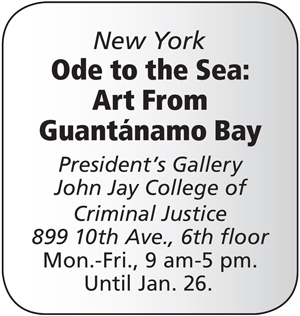
Vol. 81/No. 47 December 18, 2017
Guantánamo prisoners’ art brings threats
from US gov’t
The crackdown comes after the exhibit by eight current and former inmates began getting national and international attention. In addition to making the art public, the exhibit also puts the spotlight on Washington’s brutal and dehumanizing treatment of the prisoners.

“Ode to the Sea: Art from Guantánamo Bay” opened at John Jay College of Criminal Justice Oct. 2 and will be up until the end of January. The art was created at Guantánamo between 2010 and today. Four of the prisoner artists have since been released. I urge readers to go see the display.
The art program at Guantánamo started in 2009. The Pentagon hoped it would distract prisoners from protesting the abuse they suffered and conflicts with guards.
When inmates were moved from their cells to take art classes they were shackled and searched. After arriving they were searched again. They then had shackles taken off their hands, but kept on the legs.
In 2013, as a hunger strike against their oppressive conditions spread to about 100 of the then 166 detainees, Washington ordered an armed raid on the camp. Soldiers seized artwork and legal documents from the cells. Documents were eventually returned, but artwork never was.
The mesmerizing sea
As with much of the art produced by workers behind bars, the majority of the paintings made at Guantánamo show scenes of the outdoors. A big majority of the items exhibited at John Jay are related to the sea — showing storms, boats, bridges, beaches, shipwrecks, waterfronts and lighthouses. An essay in the exhibit catalog by Mansoor Adayfi explains why. Adayfi is a Yemeni citizen who was imprisoned at Guantánamo from 2002 when it opened until 2016. He was then sent to Serbia.He describes how when the detainees first arrived they were ferried from the aircraft to Guantánamo, gagged, blindfolded and shackled. They had no idea where they were. But they could hear the sea all around them. Some of them were Afghans, who had never seen the sea. All that they knew was that “it was a lot of water that kills and eats people,” he writes. We “tried to explain” but “that made them even more afraid.”
Their interrogators used this fear to threaten them, saying, “When we finish with you here, you will be taken to the sea and you will be thrown there.”
Detainees who came later told them they were at the Guantánamo Naval Base in Cuba, on territory occupied by the U.S. against the will of the Cuban people and their revolutionary government.
The barbed wire fences that ringed the prison camp were covered from top to bottom with green tarp to stop prisoners from seeing the sea only a few hundred feet away. They tried lying on the ground to get a glimpse in the little space below the tarp. Then guards closed that space. They climbed to see above the tarp, and guards built the fences higher.
In 2014 news came that a hurricane was heading towards Cuba. The camp administration decided they had to take down the tarp.
“We all faced one direction — toward the sea. It felt like a little freedom, to look at it,” Adayfi writes.
The tarp remained down for four days and the detainees started making art about the sea. Some wrote poems. And everybody who could draw, drew the sea.
Some began making sculptures of boats, using debris they found around the camp.
“Most of these drawings took months to complete and months to get approved. They were searched, scanned, and detained. Like us,” Adayfi says. “These drawings had a long hard journey to get to you. To meet you. Let the sea remind you we are human.”
A total of 780 people have been detained at Guantánamo. Of those, 731 were never charged or convicted but remained incarcerated in subhuman conditions for many years, some more than a decade. Of the 41 men held there today, overseen and guarded by 1,500 soldiers and staff, only 10 have ever been charged or convicted.
Major Ben Sakrisson, a Pentagon spokesperson, told the New York Times Nov. 27 that the brass found out about the exhibit from the media. News reports said the Pentagon threatened to destroy the art and order the exhibit taken down. This brought further attention and media coverage.
On Nov. 28 Army Col. Lisa Garcia of the U.S. Southern Command, which oversees the prison, told the Miami Herald that the command now recommends the prison “archive” the artwork rather than destroy it.
Related articles:
Join fight to overturn ban against ‘Militant’!
Front page (for this issue) | Home | Text-version home